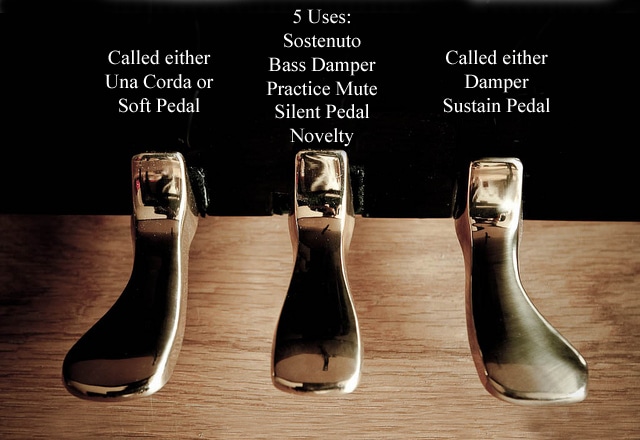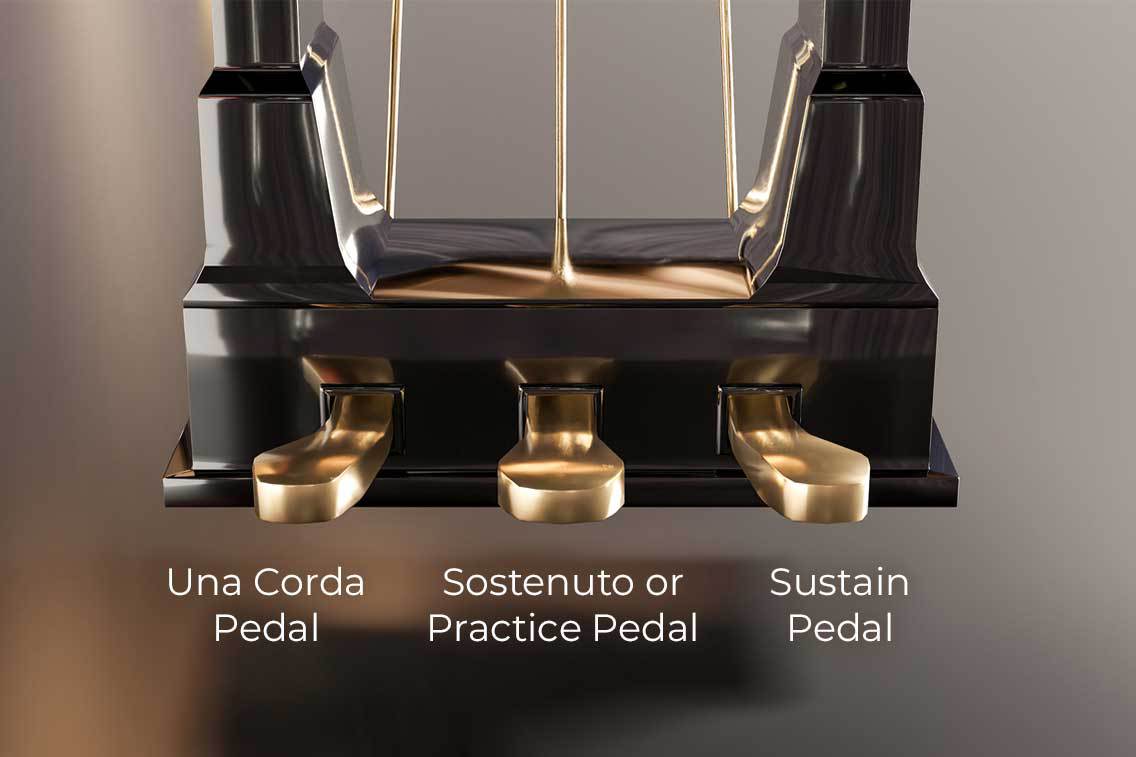Piano pedals modify the sound of the instrument. The most common are the sustain, soft, and sostenuto pedals.
Piano pedals are essential tools that enhance a pianist’s expression and dynamics. The sustain pedal, located on the right, allows notes to resonate after the keys are released, creating a lingering, connected sound. The soft pedal, or una corda, typically found on the left, softens the piano’s tone and volume by shifting the action mechanically.
The sostenuto pedal, the middle one in grand pianos, sustains selected notes while other notes remain unaffected. Mastering these pedals is crucial for dynamic control and emotive playing, thus making them integral to both classical and modern piano music performance techniques. Aspiring pianists and seasoned professionals alike focus on pedal usage to fully realize a piece’s musical potential.
The Essence Of Piano Pedals
Piano pedals are essential tools for musicians. They shape the instrument’s sound. Players use pedals to express emotions through music. Each pedal on a piano has a purpose. They make the piano versatile. Let’s dive into the world of piano pedals.
The Role In Sound Dynamics
The Role in Sound Dynamics expands musical expression. Here’s what pedals do:
- Sustain Pedal: It lets notes ring out or resonate.
- Soft Pedal: It makes the sound quieter and softer.
- Sostenuto Pedal: It holds specific notes while others keep playing.
These pedals interact with the strings inside a piano. They affect how the piano strings vibrate. This changes the sound quality.
A Brief History
A Brief History of piano pedals starts in the early 1700s. Early pianos had knee levers. Then, makers added pedals to the frame’s bottom. Cristofori, the piano inventor, created first mechanisms. Over time, designs improved. Beethoven loved using these dynamic changes. Today, pedals are a standard part of pianos.
| Period | Development |
|---|---|
| Early 1700s | First pianos with knee levers |
| Late 1700s | Introduction of frame-mounted pedals |
| 1800s | Expansion and standardization of pedal functions |

Credit: pianopricepoint.com
Diving Into The Damper Pedal
The piano’s damper pedal, also known as the sustain pedal, is a gateway to musical expression. It is the most frequently used pedal on the piano. This magical tool adds emotional depth and richness to the music. Let’s explore what happens when a pianist presses down on this essential accessory.
Mechanics Of Sustain
When pressed, the damper pedal lifts all the dampers off the strings inside the piano. This action allows the strings to vibrate freely. It results in a sustained sound even after the fingers leave the keys. Here’s how it works in detail:
| Step | Action | Effect |
|---|---|---|
| 1 | Press pedal | Dampers lift |
| 2 | Keys struck | Strings vibrate |
| 3 | Release keys | Sound continues |
| 4 | Release pedal | Sound stops |
Techniques For Proper Use
Using the damper pedal effectively is a skill that enhances a pianist’s performance. Proper use prevents a muddy sound and maintains clarity. Follow these techniques:
- Foot position: Rest the ball of your foot on the pedal, keeping your heel on the ground.
- Control: Apply gentle pressure; avoid slamming the pedal down.
- Listening: Let your ears guide when to lift the pedal to preserve sound quality.
- Half-pedaling: Slightly release the pedal to reduce sustain without complete silence.
Practicing with different pieces helps build pedal intuition. Always remember, the damper pedal is a tool to express, not to correct mistakes.
Exploring The Soft Pedal
Imagine playing the piano and wanting a whisper of sound. This magic comes from a pedal. It’s called the soft pedal. Let’s dive into how this pedal changes the piano’s sound.
Manipulating Volume And Tone
The soft pedal makes a piano quiet. It also changes the sound’s color. Think of it as a paintbrush for music.
- Press the pedal, and the piano’s hammers move. This means they hit fewer strings.
- It creates a softer, more mellow tone.
It’s not just for playing softly, though. Artists use it to express feelings in music.
The Una Corda Effect
The term ‘una corda’ means ‘one string’. But what does this mean?
- Hammers usually hit three strings per note.
- With the soft pedal, they hit only two. Sometimes even one.
- This makes the note quieter and gives a unique sound.
This pedal is a true artist’s tool. It lets pianists play with shades of sound. Each note they play can sing softly or simply whisper.
The Sostenuto Pedal Uncovered
Welcome to the captivating world of piano pedals! Specifically, let’s explore the often overlooked but immensely intriguing sostenuto pedal. Often the middle pedal on grand pianos, the sostenuto pedal has a unique role that differs from its counterparts. Let’s dive into what makes this pedal so special.
Selective Sustain
The sostenuto pedal is like a magician. It holds only certain notes and lets others pass through unaffected. Picture this: a pianist plays some notes with the sostenuto pedal pressed. These notes will keep singing even after the pianist’s hands lift off. But any notes played afterward? They get no special treatment. They are brief, as if the pedal wasn’t there at all.
- Press the sostenuto pedal after playing a note or chord.
- That note or chord will keep sounding.
- Play other notes without the pedal’s effect.
This pedal’s magic lies in its selectivity, making it different from the more all-encompassing sustain pedal. It truly adds depth to piano playing.
Application In Modern Compositions
Modern composers love the sostenuto pedal. It is a tool for creativity. New music often features this pedal, allowing for sounds that weren’t possible in the past.
Here are some examples:
| Composer | Use of Sostenuto |
|---|---|
| Claude Debussy | Creates flowing water effects. |
| John Cage | Involved in preparing the piano. |
| Arvo Pärt | For sustained harmonic textures. |
Aspiring pianists find the sostenuto pedal enriches their expressive palette. It allows sounds to layer in fascinating ways. Mastery over this pedal can elevate a pianist’s performance significantly.
Pedal Etiquette For Pianists
Understanding the role and proper use of piano pedals is crucial for pianists. Correct pedal technique enhances expressiveness and creates a professional sound. Let’s explore some pivotal aspects of pedal etiquette to elevate your piano playing.
Common Pedaling Mistakes
Identifying pedaling errors is key to improving your performance. Here are frequent missteps to avoid:
- Overusing the sustain pedal can muddle the music.
- Failing to clear the sound by releasing the pedal properly.
- Inappropriate pedal timing that disrupts the music’s flow.
- Not adjusting pedal usage to the acoustics of the room.
Practicing Pedal Control
Mastering pedals demands practice. Follow these tips:
- Start with slow practice sessions, focusing on pedal timing.
- Use ear training to hear the effect of your pedaling.
- Record your sessions and listen back for clarity and precision.
- Experiment with different pedaling techniques.
Consistent practice leads to intuitive and effective pedaling.

Credit: en.wikipedia.org
Pedals Across Different Pianos
Dive into the world of music and discover the magic of piano pedals. Each pedal on a piano adds a unique layer to the sound. Let’s explore how these pedals work on different pianos.
Grand Vs. Upright Piano Pedals
Grand and upright pianos each have a distinct pedal setup. The grand piano typically features three pedals. These are the sustain pedal, the sostenuto pedal, and the soft pedal.
The upright piano might have two or three pedals. But the functions can differ. The rightmost pedal is always the sustain. The left pedal is the soft pedal, also called una corda. Some uprights might not have a middle sostenuto pedal.
- Sustain Pedal: Holds all notes, even after releasing the keys.
- Sostenuto Pedal: Sustains selected notes, not all.
- Soft Pedal: Softens the sound.
Innovations And Varieties
Musical creativity knows no bounds, and piano pedals are no exception. Innovations have led to various pedal designs. Some pianos might have fewer or more than three pedals.
| Piano Type | Pedals | Functions |
|---|---|---|
| Digital Pianos | Varies | Mimic acoustic piano pedals |
| Practice Pedal | Fourth Pedal | Mutes the sound for quiet practice |
| Player Pianos | Varies | Control playback features |
Manufacturers like Yamaha and Bösendorfer have introduced pianos with more than the traditional three pedals. For instance, Bösendorfer offers a fourth pedal that changes tonal characteristics.

Credit: www.pianoforte-music.com
What Are the Functions of Piano Pedals?
The pedals for piano explained: the sustain pedal helps to sustain the sound by allowing the strings to vibrate freely. The soft pedal (una corda) creates a softer tone by shifting the hammers to strike fewer strings. The sostenuto pedal sustains specific notes played while others remain unaffected.
Frequently Asked Questions On What Do Piano Pedals Do
What Are The 3 Pedals On A Piano For?
The three piano pedals, from left to right, are the una corda, sostenuto, and sustain pedals. The una corda softens the sound, the sostenuto holds specific notes, and the sustain pedal prolongs all notes played.
Why Do Pianists Use Pedals?
Pianists use pedals to alter the tone and sustain notes. The right pedal (sustain pedal) maintains notes after keys are released, while the left pedal (soft pedal) softens the volume and timbre.
Are Piano Pedals Necessary?
Piano pedals are not essential for beginners but become necessary for advanced playing techniques to add expression and sustain notes.
How Do You Know When To Use A Piano Pedal?
Use the piano pedal following the sheet music indications or to sustain notes, enhance resonance, and connect legato passages. Adjust pedal use by listening for the desired sound and clarity.
Conclusion
Understanding piano pedals enriches your playing significantly. The sustain, sostenuto, and soft pedals expand expressive capabilities, each crucial for dynamic performances. As pianists explore these nuances, their music reaches new depths. Embrace pedal techniques to unlock a full palette of piano sounds, enhancing your musical storytelling.
